Post Updated: 25 Feb 2023
If you’re unsure of which axe to buy then keep reading. All the work has been done for you in this article so you can quickly compare only the best rated axes on the market today.
Here you’ll find all the information you’ll ever need to make the right decision when buying an axe for splitting firewood.
My axe reviews below have been the result of hundreds of hours of research online to put everything you need in one place, to ensure you find the right axe for your own specific needs.
I hope you find this axe comparison and buyers guide helpful in your search for the best axe for you personally. First, a quick overview of what a good splitting axe is…
TABLE OF CONTENTS:
- Splitting Axe Comparison Table
- What is the best axe for splitting firewood?
- Splitting Axe Buyers Guide
- 1. Helko Werk Spaltaxt Wood Splitting Axe
- 2. Gransfors Bruk Splitting Maul
- 3. Fiskars Super Splitting Axe
- 4. Hults Bruk Bjork Wood Splitting Axe
- 5. Husqvarna Wooden Splitting Axe
- 6. Husqvarna Steel Wood Splitting Axe
- 7. Fiskars IsoCore Maul
- 8. Gransfors Bruk Small wood splitting hatchet
- 9. Helko Werk Mini Spalter Compact Wood Splitting Axe
- 10. Estwing Fireside Friend Wood Splitting Axe
- Additional Information on the Top Rated Splitting Axes – Q&A
- What’s the difference between a wood splitting axe and a maul?
- What’s the difference between a Wood Splitting axe and a Chopping axe?
- Can you use a felling axe to split wood?
- What’s the best length axe for splitting wood?
- Is a blunt axe better for splitting wood?
- How do you swing an axe to split wood?
- Is it best to split wood wet or dry?
- Do you need to season wood before splitting?
- Things to consider before choosing a wood splitting axe
- Axe Handle Properties
- Conclusion
Straight to the point – Best wood splitting axes
A wood splitting axe is a wedge-shaped tool specifically designed to split chunks of wood along the grain. Best splitting axe brands are Gransfors Bruk, Helko Werk, Hults Bruk, Husqvarna and Fiskars.
Splitting Axe Comparison Table
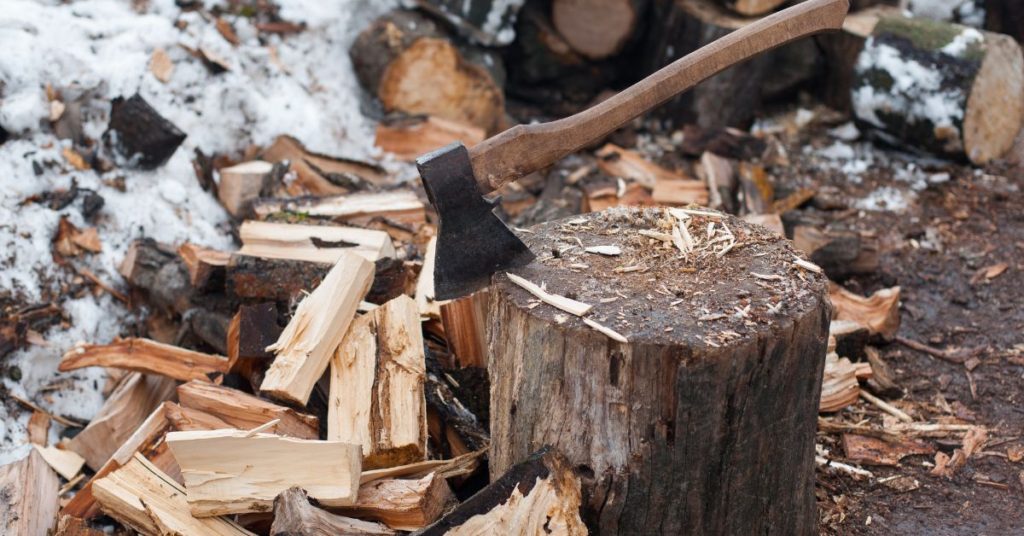
What is the best axe for splitting firewood?
The best type of axe for splitting wood is a splitting axe or maul. These are generally long-handled axes with a heavy, wedge-shaped head which helps split the wood along the grain to make smaller pieces.
Axes are an indispensable tool for any homeowner or outdoors person but not all axes were created equal – having the right type of axe for the job makes all the difference in the world.
The design of a splitting axe is different to a felling or chopping axe for example, which has a thinner, sharper blade to cut through the wood fibers. Trust me you don’t want to use a felling axe to split wood, or a splitting axe to chop down a tree… It’s like eating soup with a fork – it’s possible, but it takes a loooooong time!
If you need to split some firewood, you need a splitting axe or maul.
But of course, a single splitting axe is unlikely going to be suitable for all splitting jobs. It really depends on the type and size of wood you need to split. A maul is not necessary for most average sized logs.
I would always recommend keeping a couple of different axes to cover a variety of tasks. There are also a few essential accessories that will make life a hell of a lot easier.
A full set of tools and accessories for log splitting are listed at the end of this article but in the meantime please enjoy this list of the top 10 best rated axes for splitting firewood!
Splitting Axe Buyers Guide
1. Helko Werk Spaltaxt Wood Splitting Axe
Weight: 4-1/2 lb / Length: 28 in.
If you’re looking for one of the best splitting axes around look no further than the mighty Helko Werk Spaltaxt.
These hand-crafted axes are forged in Germany to the highest standards using C50 high carbon steel and grade-A American hickory treated with a linseed oil finish.
Suitable for splitting large rounds and heavy firewood, the dual wedge axe head design delivers powerful and very effective strikes that increase splitting efficiency, and prevents the head from becoming stuck or pinched in logs.
Although not technically a full sized splitting axe, the Spaltaxt is heavy and it breezes through some of the toughest logs due to the uniquely designed head and perfect balance. If you find a 36in. handle too cumbersome, this is the splitting axe for you.
2. Gransfors Bruk Splitting Maul
Weight: 7 lb / Length: 31.5 in.
Like any Gransfors Bruk product, this splitting maul is arguably the finest example of quality craftsmanship available today. Each component of a Gransfors Bruk axe is handmade in Sweden by master craftsmen with decades of experience – and it shows.
Yes it looks beautiful and will last a lifetime – but the real beauty of this axe is how good it is at splitting wood. It’s perfectly balanced and the geometry of the head is so cleverly designed that it just seems to slide through any piece of wood effortlessly.
The metal collar on the neck provides a shield for over-striking, which can be the death of many an axe handle, but the hickory shaft has the ability to absorb any amount of shock applied to it.
The Gransfors Bruk Splitting Maul comes complete with a vegetable-tanned leather sheath to protect your blade when not in use. ‘The Axe Book’ provides all you need to know about caring for your new axe.
Truly one of the finest splitting axes available.
3. Fiskars Super Splitting Axe
Weight: 5.85 lb / Length: 36 in.
Fiskars get a hard time from the axe purists out there. The hollow plastic/fiberglass handle flies in the face of everything a traditional axe stands for. But if you’re looking for an axe that splits wood like butter, and you don’t care about owning an heirloom axe, the Fiskars Super Splitting Axe should be your top priority!
I am actually amazed at how good this axe is at splitting wood. At a fraction of the price of some of the top axe brands, this axe performs just as well – if not better. The downside of buying a cheaper axe is the need for constant sharpening of the bit to keep it ready for action.
Fiskars use a lower grade steel for their axe heads which basically means its softer, therefore more susceptible to damage. This is not necessarily a problem as long as you are prepared to look after the cutting edge after each use.
Regular honing of the blade is required to keep this axe in tip top shape.
4. Hults Bruk Bjork Wood Splitting Axe
Weight: 2 lb / Length: 30 in.
For medium sized logs this fantastic splitting axe is lightweight compared to others, but its effectiveness is undeniable.
The Swedish are renowned for their cutting tools and the Bjork from Hults Bruk splits wood with ease. The slight twist to the cutting edge is designed specifically to help with the split and it works remarkably well. Some wrongly assume this is a flaw in the manufacturing… It’s not.
Made by master craftsmen using solid Swedish steel to hand-forge the axe head, and American hickory for the classic wooden handle the Bjork is a real workhorse that punches well above its weight.
It’s comfortable to hold and easy to swing making it ideal to use for longer periods than you would use a heavy maul.
5. Husqvarna Wooden Splitting Axe
Weight: 3.5 lb / Length: 30 in.
Husqvarna are a well known chainsaw brand in the US but they also make a mean splitting axe. This classic straight- handled axe is one of the best selling wood splitters on Amazon.
Produced in Sweden, Husqvarna are a subsidiary branch of master forgers Hults Bruk which pretty much guarantees a high quality product. This splitting axe sticks with the traditional values of the parent company by using American hickory for the shaft and a hand-forged axe head.
If you’re looking for a high quality splitting axe but maybe not quite ready to commit to a high-end ‘expensive’ heirloom axe, Husqvarna could be the one for you.
It is a beautifully crafted splitter with great reviews so check out the link below for full details of the Husqvarna Wooden Splitting Axe!
6. Husqvarna Steel Wood Splitting Axe
Weight: 5 lb / Length: 28 in.
Suited for splitting large firewood logs, this axe is designed for perfect balance and weight distribution. The poll end can be used as a hammer in conjunction with regular splitting wedges and the fiber-reinforced shaft with a stainless steel component protects the handle while ensuring long life.
The axe head is coated with a non-stick finish which reduces friction while cutting into heavy wood. Husqvarna have really excelled in their modern axe design and the feedback from customers has been overwhelmingly positive.
Its not as pretty as a classic wooden axe but damn, it does what it’s supposed to do! It’s durable, tough and stays sharp throughout many a splitting session.
The shorter length makes it ideal for novices or people of the smaller persuasion. Great axe!
7. Fiskars IsoCore Maul
Weight: 8 lb / Length: 36 in.
If you need something bigger than a standard splitting axe, the maul is the answer. These are axes with a heavy steel poll on the other end to really drive the blade through any stubborn log.
This absolute powerhouse of a maul can drive through the biggest, toughest logs out there. And the lightweight but indestructible handle enables you to generate maximum power with each swing.
It takes a bit of practice to wield this thing but once you get the hang of it – no log is safe! Recommended for experienced firewood preppers with lots of big logs to split. You also need to be pretty strong to handle the weight!
Fiskars have done it again with the IsoCore Maul. It destroys anything in its path with ease, and for the price… I’m really impressed.
8. Gransfors Bruk Small wood splitting hatchet
Weight: 3.3 lb / Length: 19 in.
Many people don’t necessarily need a full sized splitting axe or maul, and the next few axes on the list are suited for smaller jobs but are no less effective. Much like the previous Gransfors Bruk entry on this list, this splitting hatchet is top of the line.
It’s just a scaled down version on the Gransfors Bruk Splitting Maul for those who want something a bit easier to handle – but still need something that performs well.
This splitting hatchet is sized to allow one or two-handed use depending on the size and type of wood you’re splitting. The familiar Gransfors Bruk features include high-carbon steel head. American hickory is used for the shaft, and a steel collar guard for protects against over-striking.
It’s an extremely versatile cutting tool that is razor-sharp right out of the box. Great for jobs like basic kindling all the way up to splitting some pretty sizeable logs. It’s a beautiful axe that will last a lifetime – Imagine showing this off to your friends!
9. Helko Werk Mini Spalter Compact Wood Splitting Axe
Weight: 3 lb / Length: 20 in.
Designed primarily for small to medium splitting work, the Mini Spalter is an excellent choice for those looking for a classic small splitting axe.
At 20 inches long it still has enough leverage to use as a two-handed splitting tool as well as being handy for kindling and small jobs. The wide head profile makes this axe less likely to get pinched or stuck like some slimmer wedges tend to do.
Beautifully crafted, great ergonomics and a joy to hold and swing, this smaller version of the Helko Werk Spaltaxt can easily split 10-12 inch rounds of 8 inch thick hardwood.
10. Estwing Fireside Friend Wood Splitting Axe
Weight: 4 lb / Length: 14 in.
The Estwing Fireside Friend is proudly made in the USA and is forged from a single piece of steel. If you’ve heard of Estwing before, you’ll know that their tools are almost indestructible and this mini maul is no different.
The hand-sharpened bit comes ready for action and the wedge shaped head breezes through wood easily due to the weight of it. The poll end provides the means for hammering when needed and can also be hammered with a sledge for tackling really big logs.
It’s a feature not many axes can provide (since hammering the poll of a standard axe can damage the steel). I had concerns that the steel handle won’t provide ample shock resistance but the rubber shock reduction grip absorbs it easily.
Over 2000 happy customers on Amazon attest to the quality of this mighty mini maul – great for splitting logs for firewood and an all-round essential camping tool.
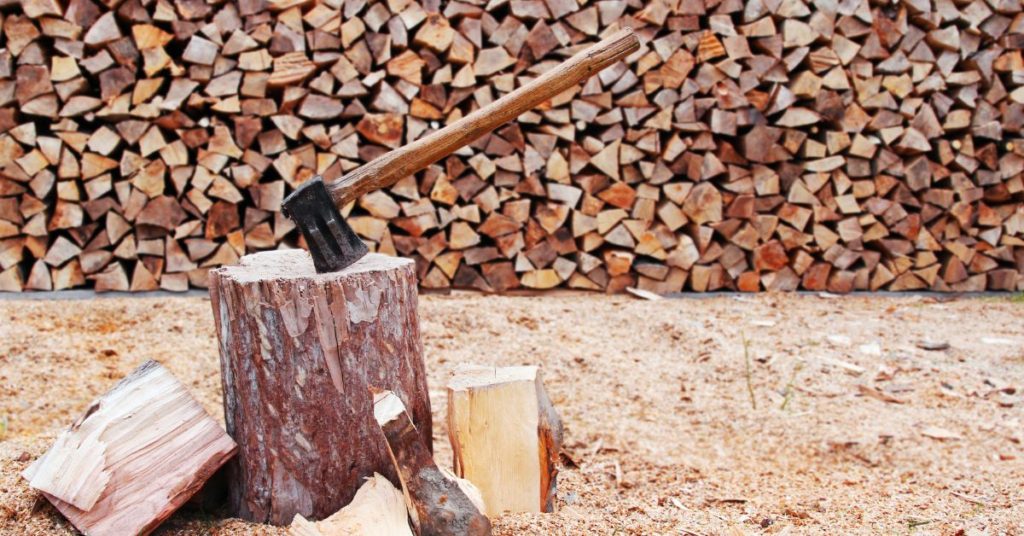
Additional Information on the Top Rated Splitting Axes – Q&A
If you’ve read through the splitting axe reviews above and still need more information on how to make the best decision, the following Q&A section should answer all of your questions.
What’s the difference between a wood splitting axe and a maul?
A splitting axe is just a lighter version of a maul. Since a maul typically weighs anywhere between 6 to 8 lbs it can be too much for some people and it’s only really necessary for the most stubborn of logs.
I only break out the maul when I’ve tried my best with the splitting axe, but they pretty much perform the same task.
A maul will have a sledgehammer on the other end of the head which provides the extra weight for driving through the wood grain. A splitting axe will not, but it will be heavier than a standard axe, usually around 3 to 6 lbs.
Both will have a much more wedge-shaped head than a chopping axe for example. This is what makes a splitting tool effective.
What’s the difference between a Wood Splitting axe and a Chopping axe?
There are 2 main differences between a splitting axe and a chopping axe. Firstly, the splitter head is thick and heavy with a relatively dull blade or ‘bit’. A chopping axe is thin and sharp to cut through the wood fibers rather than splitting it along the grain.
Secondly, the handle length of a splitting axe is much longer which allows more force to be generated during the swing. It also ensures the blade doesn’t end up swinging towards your legs after you split the log.
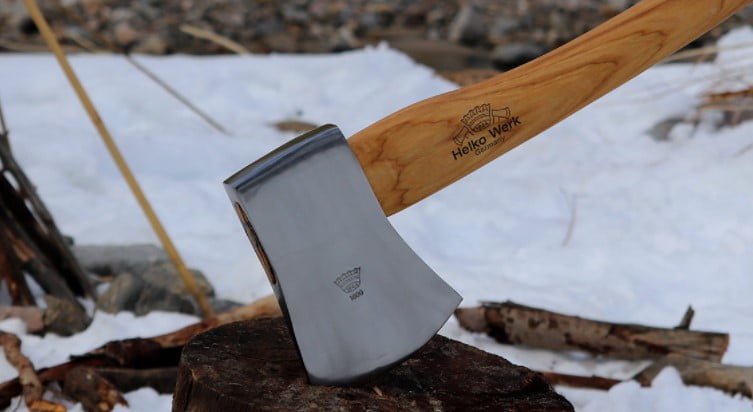
Can you use a felling axe to split wood?
A felling axe is used to fell trees (obviously). A good felling or chopping axe is lighter than a splitting axe because the swing arc is usually a kind of sideways movement as you chop away at the tree.
You would have a hard time doing this with a splitting axe – good for building muscle though!
A felling axe has a much thinner and sharper blade because we are chopping into the wood rather than forcing it to split apart along the grain. For splitting you need a heavy steel wedge not a thin blade.
Trust me, if you try to split wood with a felling axe it will still be stuck there when you wake up the next morning.
What’s the best length axe for splitting wood?
Honestly, the longer the better – within reason. The most popular full-sized splitting axes or mauls are around 36 inches in length. You won’t find many longer than this.
The general consensus is this is about the optimum length for serious wood splitting. But then it depends on what size of wood you need to split.
For medium kiln-dried firewood that arrives pre-split and you just need to half the pieces to fit in your stove, a smaller splitting tool will be perfectly adequate
Is a blunt axe better for splitting wood?
A splitting axe or maul is relatively blunt compared to a chopping axe but there still needs to be enough of an edge so the thing doesn’t bounce right off into areas not meant for cold steel!
It also needs to be sharp enough to bite into the block after you’ve split the piece of wood. You shouldn’t be honing the blade of your splitting axe to a razor-sharp edge that’s for sure – there’s just no need.
How do you swing an axe to split wood?
I felt it was pointless trying to describe how to swing an axe when there are so many videos online. I love this clip from GardenFork on how to split wood. There’s no glitzy production or fancy equipment, it’s just a quick demonstration of how one guy splits his logs for the fire:
He got the job done but he’d have a much easier time using a heavier axe or maul for that size of log. Also using a sledgehammer on the poll of an axe is not a good idea as it will deform or ‘mushroom’ the head over time.
Is it best to split wood wet or dry?
Once you’ve cut your logs I recommend splitting straight away. Some people like to leave their cut logs to dry out before splitting but there is really no need for this.
The wood may be a little more tough to split when still ‘green’ because of the sap and moisture content, but with a good quality splitting tool you shouldn’t have any problem.
The reason we leave the wood to dry out or ‘season’ is to ensure any moisture contained within the log is reduced so it burns well. An unsplit log will take much longer to dry out than a split log.
Do you need to season wood before splitting?
I split my cut logs before leaving to dry out for 6 months or so. With a good splitting axe correctly sized for the job, new or ‘green’ wood shouldn’t be a problem. A heavy maul will make short work of it.
Logs will only begin to properly dry out once they’ve been split because the bark will hold in moisture. I’d recommend you cut, split then stack your wood in early spring and leave it to season in the wind and sun before moving to your shed.
Related Article: How To Build A Shed For Wood Storage
Things to consider before choosing a wood splitting axe
Log size
The size and quantity of wood you plan to split will be the key factor in your choice of axe. A splitting maul is necessary for some of your biggest pieces of wood but not essential for daily prepping of firewood.
Some people find these too heavy to swing with good form so a good-sized splitting axe is recommended to split your average sized pieces.
Axe type
There are hundreds of axes available for splitting wood. These range from cheap mass produced hatchets all the way to the finest hand-forged heirloom pieces from the like of Gransford Bruks.
Do you prefer a natural wooden handle or a modern synthetic one? If you don’t want the hassle of oiling your wooden handle maybe a plastic one would be better for you.
Handle Material
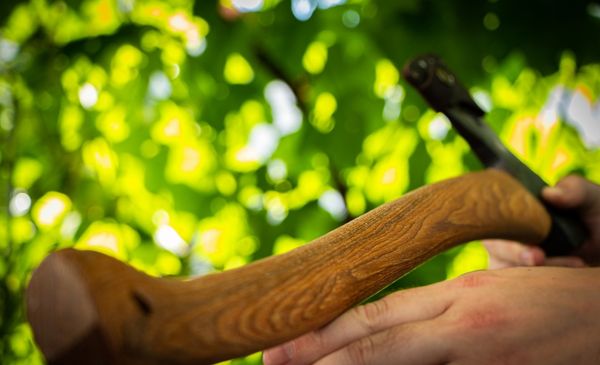
Splitting axe handles are made of one of three materials: hardwood, a composite material such as plastic or fiberglass, and less common forged steel.
Traditional wooden axe handles are the most popular – they are the classic axe handle material that has been used for centuries; lightweight, comfortable and naturally shock absorbent.
The downside is that wood is sensitive to the environment. It can swell and shrink depending on temperature and humidity, and will also soak up water and other elements that will eventually destroy your handle if it is not sufficiently protected.
It’s also the axe handle most susceptible to overstriking – if you miss a swing and the force of the blow hits the handle, you can end up snapping your axe – no matter how much you paid for it!
But wood handles are also the easiest to replace, and they also can be easily modified to suit your needs by adjusting the size, shape and finishing (oils, waxes or lacquers). The highest-quality axes available today are all made with wooden handles.
Composite handles are a mix of fiberglass reinforced plastic that will last forever. Some of the composite handles in modern splitting axes are almost indestructible and provide excellent grip, but lack the feel of a natural wood handle.
The disadvantage of a composite handle is they are not replaceable. If you mangle your handle, you’ll have to replace your axe.
Steel axe handles are forged in a single piece of steel with the head of the axe combined. They are they most durable option but provide little shock absorption when splitting logs.
Handle Length
The length of the handle is a key factor when choosing a splitting axe. There are 14 inch splitting axes like those listed above that are great for smaller splitting jobs, full-sized 36 inch mauls and everything in between.
The longer the axe handle, the more power you can generate, but it also requires a bit more experience to wield a big axe – and not everyone can swing a full-sized splitting axe!
If you’re new to log splitting, the best axe for splitting wood will have a 28 to 30 inch handle. As you gain experience you may want to upgrade to a longer handle.
Overall Weight
Standard splitting axes are equipped with heads that weigh anywhere between 3 and 6 pounds, where mauls can weigh as much as 8 pounds. For most people, the best axe for splitting wood will weigh between 4 and 6 pounds as these are far easier to handle and will do nicely for most splitting jobs.
Many people make the mistake of buying the biggest splitting axe they can find, thinking that bigger is better, right? Sure, if you’re strong enough to swing an 8 pound maul for hours on end, more power to you, but an axe you can control and feel comfortable with is a far better choice.
Budget
One thing I’ve learned over the years is that more expensive doesn’t always mean best. I’ve had axes that cost hundreds of dollars fail on me, and I’ve been surprised how effective a cheap axe can be.
Take a look at this article I wrote on Fiskars axes. Fiskars produce a full range of axes at a budget price and they are surprisingly good.
What size of wood splitting axe do I need?
Remember when splitting wood, the aim is to achieve this with one decisive swing of the axe. Big logs require a big axe, small logs can be split with a smaller axe. Sounds obvious right?
I use the Gransford Bruks 31inch splitting axe for all my log splitting because it’s just a powerhouse. This is by no means the only axe I would recommend, it’s just what I use, but for smaller logs, say with a diameter of 6-8 inches, something like the Hults Bruk Bjork will do you fine.
Do I need a sledgehammer for splitting wood?
A sledgehammer is a necessary component of log splitting. There will be times when no matter how good your axe is, it will get stuck. A sledgehammer should be used with a wedge to help pry open the log and free your axe.
Do not use a sledgehammer on the poll of your axe! This is bad. It will damage your axe.
How to split wood with a wedge?
Using a wedge can be very helpful if you don’t manage to split the log in one swing or if the axe gets stuck in the wood. Simply use your sledgehammer to drive the wedge into the crack and give it a few good hits. This will release the stuck axe and complete the split.
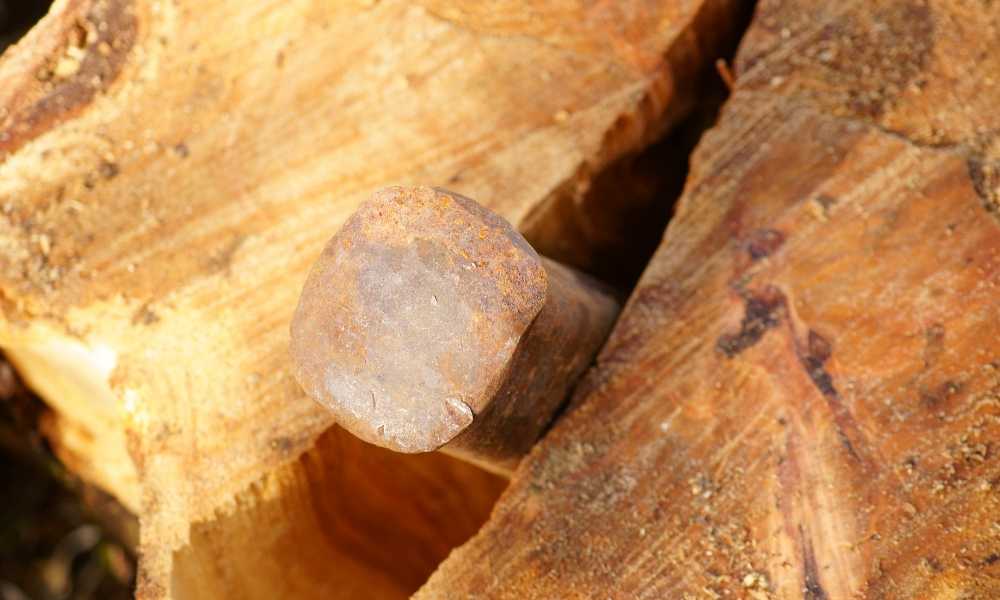
Best Rated Wood Splitting Axe Brands on this List
Here are the manufacturers of the best splitting axes reviewed on this page:
Which of the Best Wood Splitting Axes Should You Choose?
There are so many options out there for a splitting axe it can be difficult to decide which one is best suited to you and your specific requirements. To go back to basics, there are really only two types of splitting axes; classic wooden handled or modern synthetic handled.
If you’re having trouble picking the best splitting axe, fear not. Below are some pros and cons about each type of splitting axe to help you narrow down your options.
Axe Handle Properties
Wooden handled splitting axe features
- Great natural feel
- Absorbs shock
- Easily replaced
- Easily modified (length/finish/shape)
- Inexpensive
- Susceptible to the elements
- Requires maintenance & care
Composite handled wood splitting axe features
- Impervious to the elements
- No maintenance required
- Lightweight
- Indestructible
- Not replaceable
- Lacks feel of wood
- Expensive
Conclusion
The best type of axe for splitting wood is a splitting axe or maul. These are generally long-handled with a heavy, wedge-shaped head which helps split the wood along the grain to make smaller pieces.
For most users, a large splitting axe will be more than enough to handle your woodpile but I would recommend a medium-sized splitting axe for most of your logs and a large one for the big stuff.
Having 2 companion pieces will ensure no log is unsplittable! A few accessories will complete the set. Here’s my recommendation for a full set of splitting tools:
- For kindling: Snow & Nealley Outdoorsmans Belt Axe
- For smaller logs: Hults Bruk Bjork Splitting Axe
- For large logs: Gransford Bruks 31inch splitting axe
- Sledgehammer: Truper 6-Pound Sledge Hammer 36in.
- Hand protection: SHOWA Atlas Rubber-Coated Gloves
- Wood storage: KINGSO Firewood Storage Rack
- Splitting wedges: Estwing Sure Split Wedge (x 2)
I hope this article has been of some assistance. Please post any comments you may have on the subject of log splitting and I’ll be happy to help.

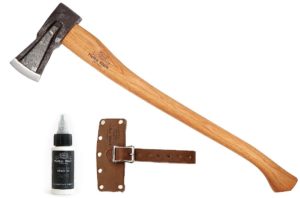

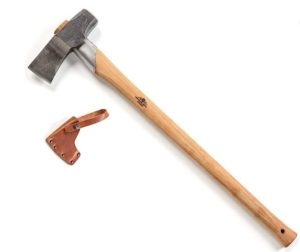

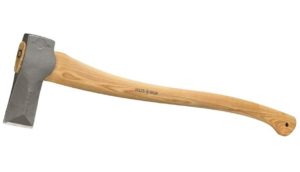
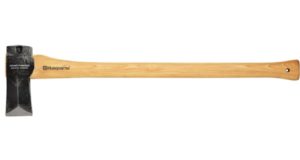
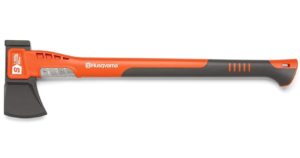
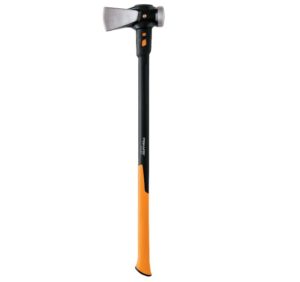
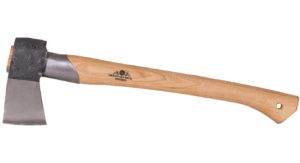









Leave a Reply